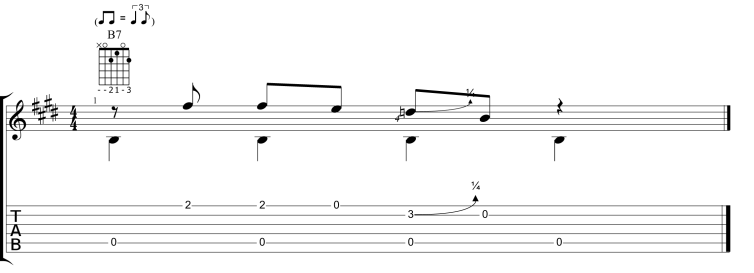An Easy Guide To Open Tunings For Blues Guitar (2)
In this lesson you will learn the typical riffs and licks that every Blues guitarist needs to know when playing in Vestapol tuning (Open E or Open D). They are easy to play and sound great – an unbeatable combination. These are building blocks that can be played in many Blues songs. At the end of this workshop I put together the pieces and play an example chorus. If you haven’t already done so please read the first part of this series . All examples are taken from my new ebook ‘An Easy Guide To Open Tunings For Blues Guitar’, which contains many more examples and ideas (available at my website).
Classic Blues Songs In Vestapol Tuning
Here is a list of well known Blues classics that were recorded in Vestapol tuning. By listening to these recordings you get an idea what Vestapol tuning sounds like when used in a Blues context:
- Police Dog Blues – Blind Blake (CD: Any ‘Best Of’ compilation)
- Ramblin’ On My Mind – Robert Johnson (CD: ‘The Centennial Collection’)
- I Believe I’ll Dust My Broom – Robert Johnson (CD: ‘The Centennial Collection’)
- Preachin’ Blues – Robert Johnson (CD: ‘The Centennial Collection’)
- If You Don’t Want Me – Mississippi John Hurt (CD: ‘D. C. Blues – The Library Of Congress Recordings, Vol. 2’)
- Kassie Jones – Furry Lewis (CD: ‘Furry Lewis’ Folkway Records FS 9829)
- Poor Boy A Long Way From Home – John Fahey (CD: ‘The Legend Of Blind Joe Death’ und ‘On Air’)
- Little Woman You’re So Sweet – Blind Boy Fuller (CD: ‘Volume 2’ JSP7772 (4-CD-Box))
- You Got To Move – Fred McDowell (CD: ‘You Got To Move’ Arhoolie 304)
- Good Morning Little Schoolgirl – Fred McDowell (CD: ‘The Alan Lomax Recordings’)
- Boogie Woogie Dance – Tampa Red (CD: Any ‘Best Of’ compilation)
- Baby, Please Don’t Go – Bukka White (CD: ‘Sonet Blues Story’)
Vestapol-Licks For The I Chord
You need just one finger to play a whole lotta Blues! There are countless licks that use just the open E string (root), it’s third fret, the open B string and it’s third fret. Here is one example:

Don’t forget to bend the notes on the third fret to get the bluesy feel.
Now try to invent some licks on your own with these four notes and improvise – while playing a Steady Bass .
And here comes the legendary train whistle – another must-know-lick!

Please note that you could play both examples in standard tuning also – they only use the three strings that are tuned to the same pitch in both tunings!
Vestapol-Licks For The IV Chord
The root note of the IV chord is on the 5th fret of the low E string. It’s much easier to reach the major third on the 2nd fret of the A string. That’s why a typical move in Vestapol on the IV chord is to walk up to the major third in the bass. Please note that this is a pickup (that is it begins in the measure before).

You can play these two notes with your index (1st fret) and your middle finger (2nd fret) or with just your middle finger. Once you hit the destination note (2nd fret) you form the complete chord. Hold this chord and move only the pinky to play the melody from the next example.
Another very common move is to use the pinky to play note on the 3rd fret of the highest string:

Now try to invent some licks on your own with these three notes (2nd fret B string, open and 2nd fret high e string) and improvise.
Vestapol-Licks For The V Chord
On the V chord there are again only four notes that are commonly used:

Again: Form the complete chord, hold it and move only the pinky to play the melody. To play the high E string open remove the ring finger from the fretboard, but the rest of the chord stays intact.
Putting It All Together
The last audio example shows a complete 12 bar Blues with intro in Vestapol tuning with just the riffs you have learned so far (the turnaround is from the first part of this lesson).
Now it’s your turn to come up with your own variations. Sing something about ‘I woke up this morning and my baby was gone’ or about ‘drinking moonshine whiskey’ and you could make a whole career out of this. It happened before!
You’ll find many more examples like this in my new ebook ‘An Easy Guide To Open Tunings For Blues Guitar’ (available at my website). In the next article you’ll learn to play in Spanish tuning. Stay tuned!
Lesson by Andi Saitenhieb. www.andisaitenhieb.de
“The artists you work with, and the quality of your work speaks for itself.”
Tommy Emmanuel
© Copyright Fundamental Changes Ltd 2024
No.6 The Pound, Ampney Crucis, England, GL7 5SA
